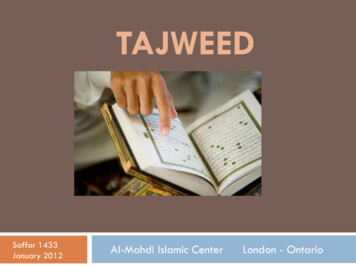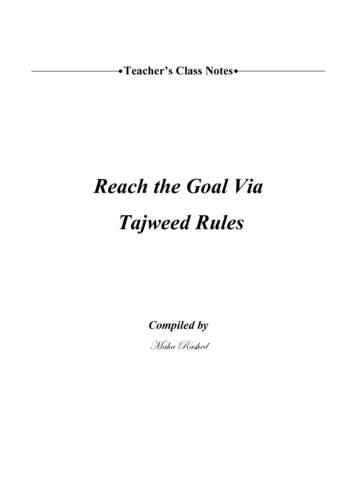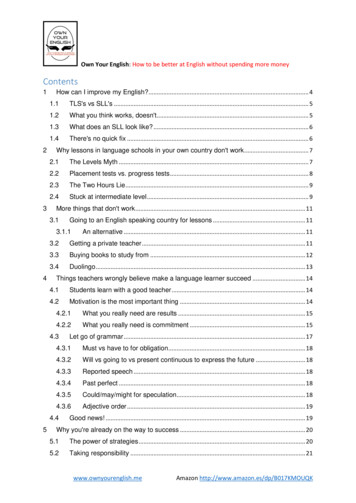
Transcription
Learn TajweedThe Easy Way
The best among you is he who learns and teaches the Qur'an. (Bukhari)Learn TajweedThe Easy WayA C A D E M Y
Copyrights for the publicationAll rights are reserved with “Edusuite Solutions Private Limited”.No part of this publication may be reproduced, stored in a retrieval system ortransmitted in any form or by any means, electronic,mechanical, photo copy, recording or otherwise without priorpermission of “Edusuite Solutions Private Limited”Book Name:Learn Tajweed - The Easy WayCompiled by:Dr. Abdulazeez AbdulraheemFounder & Director: Understand Al-Qur’an AcademystEdition 1 :April 2020Pages:28Research & DevelopmentMohsin SiddiquiAbdurrab Khurram QuraishiAamir Irshad, Abdul QuddoosDr. Zarish TabassumUsama Saleha, Qari SaidurrahmanObaidullah Muzzammil HaqueKafeel Ahmad, Irshad AlamMohammed FurqanReviewersDr. Usman AhmadMaqsood HusainAdvisorsMohsin Siddiqui, Sana Dossul, Qari ImranContributersKhawja Nizamuddin AhsanDaleeluddin KhanZubair AbdurraheemAbdul Qadir FazlaniTranslatorsDr. Abdul Basit SiddiquiArjan Ali, Sayyed AneesulhasanSayyed Aneesul HasanMujahidullah KhanArabic Font DesignersLate Shakeel Ahmad, Ayesha FawziaGraphic DesignersAhmad Ghazi, Shabana ParveenAbdul Quddoos, Kafeel AhmadQur’anic Words Count
In the name of Allah, Most Beneficent, Most MercifulTable of ContentsLessonsNumberLessons Name,1,,23,4PageNumberLessonsNumberDouble Dhammah ( ٌ ) ـ 1224Shaddah ( ّ ) ـ 1325Shaddah with Tanween1326Shaddah on ( )ن & م 13627Revision - 21 to 2614628Rules of Madd145,PageNumber2345,Lessons Name5Fataha (Zabar)729Separated Letters146Alif Madd ( )ـ َﺎ 730Laam of the Word "Allah"157Kasrah (Zair)731Shamsi Letters158Yaa Madd ( )ـ ِْﻰ 832Qamari Letters159Dhamma (Pesh)833Rules of Meem Sakinah1610Waw Madd ( )ـ ُْﻮ 834Rules of Raa1611Revision - 5 to 10935Show (Izhar)1712Standing Fathah936Hide (Ikhfa)1713Standing Fathah, Standing Kasrah, inverted Dhammah937Merge (Idhgaam)14Sukoon1038Change (Iqlaab)15Soft Waw ( )ـَْﻰ 1039The Tiny Noon (Noon Qutni)1916Soft Yaa ( )ـ َْﻮ 1040Silent Letters1917Hamzah Saakinah1141Revision - 28 to 402018Qalqalah Letters ( )ق ط ب ج د 1142Rules for Starting & Stopping of the Recitaiton2019Hams (Sukoon on )ت & ك 11Stop Signs while Recitation2320Revision - 12 to 191220 frequently repeated words in the Quran2321Double Fathah ( ً ) ـ 12Prefixes and suffixes2422Double Kasrah ( ٍ ) ـ 123(to show Noon Saakinah & Tanween)(to hide Noon Saakinah & Tanween)(to Noon-Saakinah/Tanween with next letter)(Noon-Saakinah/Tanween with Meem Saakinah)1818
Lesson-1a: Introduc onClarifica onThis course is for the whoŸ Knows how to recite the Qur’an butŸ does not know the right way to recite it, i.e., with Tajweed.TajweedTo recite the Quran as par the Makharij & Sifaat of le ers and the rules of recita on.ِ َ َ ﻗ اﻋﺪ َ ِ ﺻﻔﺎت صضطظ ـﺎ ْ َ َا ـ ْ ُ ُ ـ ـ َﺎ ِـﻲ ـ ُﻮ م ، ن ـ َﺎﷲ ـ ُﺎﷲ َ َ ﻣﺨﺎ ِج قغخ ـﺎ RemainingLe ersْ َ َ ْاو أي ْ َْ َ اك ات ََ َاق اط اب ا َ َاد These rules occur On every pageIn every lineTherefore, it is necessary to learn Tajweed.Importanceَ ﻋﻠﻴﻪ ِ َﺳﻠﻢ َﻗﺎ َ َ ُ ﻋﻦ أ َﺑ ِﻲ ْ َََ أن اﻟﻨﺒِﻲ ، ُ ﺿﻲ ا ُ ﻋﻨﻪ ِ ُ ﻋﺒﺪ ِ َ ﻟﺒﺎﺑﺔ َ ِﺸﻴﺮ ِﻦ ْ َ َ ُ ﺻﻠﻰ اﷲ َِ اﻟﻤﻨﺬر ََََُُْْ َ »:َ ْ آن ِ ْ ﻣﻦ ﻟﻢْ َ َﺘﻐﻦ ِﺎﻟﻘ . ﻓﻠﻴﺲ ِﻣﻨﺎ « ر اه أﺑﻮ دا د ﺈﺳﻨﺎد ﺟﻴﺪ ŸŸAbu Lubabah Bashir bin Abdul-Mundhir (May Allah be pleased with him) reported: The Prophet ﷺ said, "He who doesnot recite the Qur'an in a pleasant tone is not of us.'‘ [Abu Dawud].However, reci ng in pleasant tone is not enough if you have Problems in Makharij Problems in Sifaat Problems in other RulesWe recite with mistakes b’cosŸ Improper learningŸ Mother tongue effects carried into Arabic (Ex: Urdu speakers reci ng like Urdu)Ÿ No exposure to TajweedObjec vesŸ To help you to recite the Qur’an correctly (i.e., with Tajweed)Ÿ To teach you the main rules rules of Tajweed including their importance and the possible logic (why they are imp)Ÿ To prac ce these rules on Freq. occurring words (a total of 350 words from all the lessons that occur 40,000 mes inthe Qur’an! 50%!!)To give you prac cal ps on how to implement these rules
Lesson-2a:Makhraj: Join the outer parts of the lips.ٌ م ٍ م ً م Makhraj: Join the inner parts of the lips.ٌ ب ٍب ً ب ُ م ِ م َ م ْ َام ُ ب ِب َ ب َاب Lesson-3a:Makhraj: Form a circle of the lips, and then separate them to produce the soundCommon mistakes: Don’t say it as va!! ٌو ٍ و ًو ُو ُُْ ﺟﻮه َو َ ْﺳ َاس ِ و ﻳ ُ َ ْﺳ ِ ُس Makhraj: Touch the lower lip to the edge of the upper teeth. ٌف ٍ ف ًف ُف ِ ف َف ا َ ْو َ أ ْ ٰﺣ َْ اف Lesson-4a:Makhraj: Touch the p of the tongue to the edge of the upper teeth and blow with a light sound.Common mistakes: ØDon’t say it as za!!ØDon’t take out more than the pٌ ث ٍ ث ً ث ُ ث ُﺛﻢ ِ ث َِْ ﻛﺜﻴﺮ َ ث ْ َ ﻛ َ ْﺛ ْ َ اث ََْ َ اﺛﻤ Lesson-5a:Makhraj: Touch the p of the tongue to the edge of the upper teeth and blow with a strong sound.Common mistakes: Ø Don’t say it as za!!Ø Don’t take out more than the pٌ ذ ٍ ذ ً ذ ُ ذ ُ َأﻋُ ذ ِ ذ َ ِ اﻟﺬﻳﻦ َ ذ َِ إذا ْ َاذ َ ََْ أذﻫﺐ Lesson-6a:Makhraj: Touch the p of the tongue to the edge of the upper teeth and blow with a very thick& high sound. Say َ ذ with ‘awe’!
Common mistakes: Ø Don’t say it as Zaw; Zoy!!Ø Don’t take out more than the p ٌظ ًظ ٍظ ُظ ْ ُ ﻇﻠﻢ ِظ َِْ ﻋﻈﻴﻢ َظ ِ َ ﻇﺎﻟﻢ َْ اظ َ َُْ اﻇﻠﻢ َ ت ْ َ ات َ د َاد Lesson-7a:Makhraj: Touch the p of the tongue to the roots of the upper teeth.ٍ ت ٌ ت ً ت ُ ت ِ ت Makhraj: Touch the p of the tongue to the roots of the upper teeth.ٌ د ً د ٍ د ُ د ِ د Makhraj: Thicken the tongue and touch it to the upper gum; Say ت with ‘awe’Common mistakes: Ø Don’t say twa or taa ٌط ٍط Ø Don’t make your lips round for ط ًط ُط َُِْ ﻳﻬﺒﻂ َط َﻃﻴ ْ ًا ِط ْ اﻟﺒﺎﻃﻞ ِ َْ َ َاط ََُ َ أﻃﻌﻤﻬﻢ Lesson-8a:Makhraj: Touch the p of the tongue to the edge of the lower teeth and blow with a strong sound.ٍ ز ً ز ٌ ز ُ ز ِ ز َ ز ْ َاز Makhraj: Touch the tongue to the edge of the lower teeth and blow with a so sound. ٌس ٍس ًس ِس ُس َس َْ اس Makhraj: Thicken the tongue, touch it to the edge of the lower teeth and blow with a thick and high sound.Common mistakes: Ø Don’t say sa or swaٌ ٍص ص Ø Don’t make your lips round for ص ً ص ُ ص ُ ُِ ﺻﺪور َْ َ ص ِص اص َ َ ﺻ َ َ َ أﺻﺒ َ َ ُﻫﻢْ َﺗ ْ َِ اﺻ ْا اط
Lesson-9a:Makhraj: Touch the p of the tongue to the upper gums near the roots of the teeth.ٌ ل ً ل ٍل ُ ل َ ل ِل ْ َ ا Makhraj: Touch the p of the tongue to the upper gums a li le above the roots of the teeth.ٌ ن ً ن ٍن ُ ن َ ن ِن ْ َان Makhraj: Touch the p of the tongue to the upper gums above the roots of the teeth.Common mistakes:Ø Don’t say َر as ra (low). It is like raw but without making your lips round for raw. Ex: Rat, Rot.Ø Arabic Ra is between Mexican and English R.ٍ ر ًٌِ ر َ َْ ﺣﻠﺔ ُِْ َِ ﻧﺼ ُ اﷲ ََ َ ﺻ ِ اط ْ َ ا َْ َ أﻛﺒﺮ Lesson-10a:Makhraj: Touch the MIDDLE (not the edge) of the tongue to the palate or roof of the mouth. ٌج ًج ٍج ِج ج َ ا َج Makhraj: The middle of the tongue is close to touching the palate or roof of the mouth. ٌش ًش ٍش ُش ِش َش َْ اش Makhraj: The middle of the tongue is close to touching the palate or roof of the mouth.Common mistakes: Don’t lose the le er esp. in ِي ٌ ى ٍى ً ى ُ ى ُ ُِْ ﻳﻤﻴﺖ ِى ﻳﺤﻴﻲ ْ ِ ْ َُ ى َِْ ﻳﻮم ْ َ ا ى َ ﻋﻠﻴﻬﻢ ِْ َLesson-11a:Makhraj: Touch the edge of the tongue to the roots of the molars, either to the right or le .ُ ، ظ ، ذ ، ز Common mistakes: Don’t say ﺿ َا ض ض ض ُ ِض ض ُ ْ َ ً ﺿﻴﺂء َ ِ ﻣﻐﻀ ْ ِب َْ َ ض اض َ َ ْ َْ ِّ َ أﺿﺤﻚ ﺿﺂﻟﻴﻦ
Lesson-12a:Makhraj: Touch the inner part part of the tongue to the roof of the mouth right at the back.ٌ ك ُ ك ً ك ٍك َ ك ِك ْ َ اك Makhraj: Touch the inner part of the tongue to the roof of the mouth right at the back (behindthe uvula) A li le inside!َCommon mistakes: Ø Don’t say َك or خ Ø Don’t say it with a low sound. ٌق ٍق ًق ُق ْ ﻗ ُﻞ ِق َ ﻗﻴﻞ ِْ َق َ َﻗﺎ َاق ُ َ َأﻗ ب َ ء ْ ا َء ْ َﻓﺄﺗُ ْا Lesson-13a:Makhraj: From the lower part of the throat.Common mistakes: Ø Don’t say without a jerk.Ø It is not same as ‘a’ in English. ٍء ٌ ء ً ء ُ ء ٌ ُأﻣﺔ ِ ء َ ِ إﻳﺎك َ َﺟ Makhraj: From the lower part of the throat.Common mistakes: Don’t say without a jerk (esp. during recita on)ٍ ه ٌ ه ً ه ُ ه َﻫُ َﻮ ِ ه ﻫﻲ َ َِ ه َٰ ﻫﺬا ْ َاه Lesson-14a:Makhraj: From the middle part of the throat.Common mistakes:ٌ ع ØØØØDon’t say ع as ء Anything too much becomes bad.If you say ح ، ع properly, they appear normal.For prac ce and ge ng control, you can exaggerate. But not during recita on. ٍع ً ع ُ ع ُ َ َْ ﻳﺴﻤﻊ ِع ُ ﻋﺒﺎد ََِ ع َ ﻋﺎﺑﺪ ن ُِ َْ َع َُُْ أﻋﺒﺪ Lesson-15a:Makhraj: From the middle of the throat Take a deep breath and release it from inside the throat!Common mistakes: Don’t say ح as ha!
ٌ ح ٍح ً ح َْ َ ا ح ِح ُ ْ َ ْ َ ﺣﻤﻦ ﺣﻴﻢ ِ ْ ِ اﻟﺤﻤﺪ اﻟ ِ ٰ ْ اﻟ ُ ح ُ ُ ﺣﺪ ْ َد Lesson-16a:Makhraj: From the upper part of the throat.Common mistakes: Don’t recite it thin. It is a thick and high sounding le er.ٌ غ ٍغ ً غ ُ غ َ َ َ ْ ُﻏﻔ اﻧﻚ َ غ ِغ ٌ ﻏﺸﺎ َة َ َِ ﻏﺎﺳﻖ ٍ ِْ َغ َْٰ أﻏﻨ Lesson-17a:Makhraj: From the upper part of the throat.Common mistakes: Don’t recite it thin. It is a thick and high sounding le er.ٌ خ ٍخ ً خ ُ خ ﺧﺴﺮ ٍ ْ َُ خ ََ َ ﺧﻠﻖ ِخ ٍ َ ِ ﺧﻼف ْ َ ا َْ أﺧ َ َج Lesson-18a: Review (Makharij of le ers)ِ َ َ ﻗ اﻋﺪ َ ِ ﺻﻔﺎت َ َ ﻣﺨﺎ ِج To recite the Quran nicely. How? By taking care of Makharij & Sifaat of le ers and the rules of recita on. صضطظ ـﺎ ْ َ َا ـ ْ ُ ُ ـ ـ َﺎ ِـﻲ ـ ُﻮ م ، ن ْ َExit: ﻣﺨ َج ـ َﺎﷲ ـ ُﺎﷲ قغخ ـﺎ RemainingLe ersْ َ َ ْاو أي ْ َْ َ اك ات َاق َاط َاب ا َ َاد Place where the sound of the le er comes out from.The ar cula on point of the le er.Plural of ﻣﺨ ج is ﻣﺨﺎ ج ( )اﻃﺒﺎق ء Very thick & high( )اﺳﺘﻌﻼء High( )ﺗﻔﺨﻴﻢ Thick( )اﺳﺘﻔﺎﻟﻪ Low
Remember the 3 setsThick:ََ خ غ َ َق Thick and High:َ ص َ ض َط َظ Very Thick and High:Using a le er poemitfromredle as midTongue hasmany 12 fromthe Tipfrom its edges aresix from the throatare from the lips10 Important features of the Poem1. Whole set2. on finger ps3. in Makhraj order4.5.6.7.in Makhraj groupsof rhyming le erswith ac ons (TPI)that relate to Sifaat8. Repeated with different Harakat and Rules9. Tajweed rules make sense!10. Easy to explain and understand the SifaatLesson-19a: Words with FathahThe Arabic vowel signs are called 'Harakaat'. For the sake of brevity and ease, we will refer to them as signs. They are:َ We willFathah (Zabar); Kasrah (Zair); and Dhammah (Pesh). The easiest sign (Harakah) to pronounce is Fathah (e.g. )ب .call such le ers Fathah-le ers. Fathah le er is read fastly. It gives the sound of 'a' for the le er upon which it rests.Note:Thick:َThick and High:َ خ غ َ َق Very Thick and High:Remaining le ers are thin.Prac ce: Words with thin le ers:Words with Thick& High le ers:َ ََ َ ﻟﻚ َ َ ﻣﻊ َ ﺟﻌﻞ َ ﺧﻠﻖ َ َﻠﻎ َ َ َ َ َ َق Words with Thick le er:Words with Very Thick& High le ers:Lesson-20a: Words with Alif MaddAlif Madd: When Alif comes a er a fathah le er,it is called Alif Madd.For example: َا Note: Thick:Thick and High:Remaining le ers are thin.Words withthin le ers:Words with Thick& High le ers: َﻗﺎ َﺧﺎ َﻏﺎ Very Thick and High: ﺗَ َ َك َ َ ب َ َ َ ﺻﺒ ََ ﻇﻠﻢ َ َ ﺿ َﻣﺎ َﺎ َا َﻓﺎ َ ﺻﺎ َ ﺿﺎ َﻃﺎ َﻇﺎ Word withَ َ ﻓﻤﺎ َﻻ َ َﻻ َ ََ َ َ ﻓﻼ َﰷن َ َ ﻟﻨﺎ َ َ َﻣﺎ َ َﻣﺎ Thick ﻟﻬﺎ le er: ان َ َ َ َﻗﺎ ThickWords with Veryَ َ َ َ َ َ ََ ََ َ َ ﺧﺎف ﻠﻐﺎ & High le ers: ﻃﺎﻗﺔ ﻋﺼﺎك َﻣﻀﺎن Lesson-21a: Words with KasrahNote: Thick and High:َ ص َ ض َط َظ ِخ ِق ِغ Remaining le ers are thin.Very Thick and High: ِص ِض ِط ِظ
Prac ce:Words withthin le ers:Words with Thick& High le ers:َ ِ َ ﻋﻤﻞ َ ِ َ َ ﻫﻲ ِﻟﻢ َ ِ اذا ِ َﻬﺎ ِ َﻤﺎ ِ َ ﺳﻤﻊ ﻟﻤﺎ َ َِ َ ﺻ Words with Veryِ َ ﺿﻲ ِِ ِ ﻗﻴﺎﻣﺔ َ َِ ﺎﻃﻞ َ ِ َ اط ِ ﻃﺎﻏﻴﺔ َ ِ َ ِ اﺧ َ ة Thick & High le ers: ِLesson-22a: Words with Yaa Maddْ the le er sound is stretched twice. We call this Yaa as Yaa-Madd.If a Kasrah-le er is followed by a Yaa-Saakinah ( )ى ,ْ ِ ﻣﻰ ِ ْﻰ ﻓﻰ ْ ِ ى ْ ِTake special care of ص ض ط ظ and ع خ غ .The yaa in all of these is Yaa Madd.Note: Thick and High: ﺧﻰ ْ ِ ﻏﻰ ْ ِ ﻗﻰ ْ ِVery Thick and High: ﻇﻰ ْ ِ ﻃﻰ ْ ِ ﺿﻰ ْ ِ ﺻﻰ ْ ِRest of the le ers are thin and therefore, Yaa Madd also will thin.َ ْ ِ ِ ﻓﻴﻪ ْ ِ دﻳﻦ ﻓﻴﻬﺎ ْ ِ َ ﻟﻰ ْ ِ ﻓﻰ ْ ِِ ْ ِ ﻨﻰ Words with ThickWords with Veryَ َ ْ ِ َ ﺣﺎﻓﻈﻴﻦ ِ أﺧﻴﻪ ْ ِ َ َ ﺑﺎﻟﻐﻴﻪ ِ ِﻗﻴﻞ ْ ِ ِ َ Thickَ ْ ِ ِ َ اﻃﻲ ِ& High le ers:ْ ِ َ ﺻ & High le ers: ﺼﻴﺒﻚ Prac ce: Words withthin le ers:Lesson-23a: Words with DhammahNote: Thick:ُThick and High:Remaining le ers are thin.ُ ْ ُِ ﻳﺪ Words with Thick ُ َ َﻼغ & High le ers:Prac ce: Words withthin le ers:ُ خ غ ُ ُق ُ ص ُ ض ُط ُظ Very Thick and High:َُُ َ َ ﻫﻮ َ ِ ُ ﻋﺬاب ﺘﺐ َ ِ ُ َ ﻗﺪ ُِ ﺧﻠﻖ Word withThick le er:Words with VeryThick & High le ers:ُ ُ ُﺳﻞ َُ ِ ُ ب َ ﻇﻠﻢ ِ ُ ﻃﺒﻊ َ ِ ﺿ Lesson-24a: Words with Waw Maddْ the le er sound is stretched twice. We call this Waaw asIf a Dhammah-le er is followed by a Waaw-Saakinah ( )و ,Waaw-Madd.Take special care of ص ض ط ظ and ع خ غ .ْ ُ ﻣﻮ ُ ْﻮ ْ ُ وو ُْ ﻓﻮ ْ ُ ﺧﻮ ْ ُ ﻗﻮ ُْ ﻏﻮ The Waw in all of these is Waw Madd and it will have double stretch. ُ ْو Thick and High:Note: Thick:Remaining le ers are thin.Very Thick and High:ْ ُ ﻃﻮ ْ ُ ﺿﻮ ْ ُ ﺻﻮ ُْ ﻇﻮ َ َ ﻋﻤﻠ ُ ْا ِ َ دُ ْنَ َﻗﺎﻟ ُ ْا َﰷﻧ ُ ْا ﻇﻠﻤُ ْا Words withWords with Thickُ ِ َ ِ ﻃﻮر ُ َ ِ ﺻﻮر ْ ُ ﺿ ْا ُْThick & ﺣﺎﻓﻈ ْ ا َﻛﻔَ ُ ْا َﻘُ ْلُ َﻘُ ْﻟ ُ ْنَ َ َﻠﻐ ُ ْا Very& High le ers:High le ers:Prac ce: Words with thinle ers:Lesson-25a: Words with Standing Fathah, Standing Kasrah& Inverted Dhammahٖ ٰٗ ـــــــ Standing Fathah, Standing Kasrah & Inverted Dhammah. They are like Alif Madd, Yaa Madd, and Waaw Madd.Double stretch for each.Prac ce:ََ ِ َ ذﻟﻚ َ ِ ﻫﺬا َ ِ اﻳﺖ َ ﻃﻐﻴﻦ ِ ﺬﻟﻚ َ ْ ِ ِ اﺧ َ ة ِ اﻣﻨ ُ ْا اﻳﺘﻨﺎ Dhammah ٗ َ َStanding Kasrah ﻟﻒ ِ ٖ ِﻪ Invertedِ ٖ ﻫﺬه دا ٗد ﻟﻪ (Ulta pesh)Standing Fathah
Lesson-26a: Words with Standing Fathah (Special case)Some mes the le er ى in the Qur'an is wri en but not pronounced. A standing Fathah is placed on such types of Yaa.The short form and the full form (along with connectors shown below them) are the same as in a typical Yaa. in brief,don't pronounce ى if there is a standing Fathah on the le er before it. ُﻫﺪى َ َ ﻓﻬﺪى ﻳ َ ى ا َ َ َ ﻣﻴﻜﯩﻞ ََْ ِ ﻋﻴﺴﻰ ﻣُ ْﺳﻰ ْ ِ ﯨﻚ َﻫﺪﯨﻨﺎ ﻨﯩﻬﺎ No sign on ى No sound!Prac ce:Lesson-27a: Words with SukoonvThe letters with "Sukoon" are called as "Sakinah" letters. v The letter which carries Sukoon is not to be readseparately, this is to be read by joining it with the previous letter. v For practice, in the Poem by placing Zabar above Alif,every word has placed with Sukoon. v Lesson of Sukoon is divided into six parts for ease of learning. For example to getthe proper understanding of Qalqalah, Soft letter (Lain Letters), Hams etc. v In this Book we will use only Sukoon words.ْ ِ ﻣﻦ ْ َ ﻟﻦ ْ َ ْ َﺑﻞ ْ َﻫﻞ ْ َامْ َﻟﻢْ َان ْ ﻣﻦ ِانْ ِاذْ ُﻗﻞ ْ ُﻫﻢ ُ ْ ﻟﻬﻢ ْ ِ ْ ﻟﻜﻢ َ ْ ِ ْ ﻣﻨﻬﻢ ُ ْ ِ ُ ﻣﻨﻪ ُ َ ﻟَ ْﻦ ﻣﻨﻬﺎ َ َِْ ْ َ َ ﺗﻠﻚ ْ ِ ْ َ ﻌﺪ ِ ْ َ ﺟﻌﻠﻨﺎ ﻬﺪي َ ْ َ َ ﻌﻠﻤُ ْن َ ْ َ ُ ﻳﻌﻠﻢ َََْ ﻌﻤﻠ ُ ن َ ْ َ َ ﻌﻠﻤُ ْن َ ْ َ َ ﻌﻤﻠ ُ ْن Prac ce:Lesson-28a: Words with So Waawْ then it should be pronounced so ly, and quickly, as you say it inIf a Fathah-le er is followed by a Waaw-Saakinah ( )و English words such as "mouth", "south", or "house" and not like the one in "how" or "cow".So Waaw:ْ َ ، َ ْﻮ ، ﻣﻮ ْ َ ، وو ْ َ Don’t say: mow, bow, wow, fow, ﻓﻮـ ـ ـ َ ْـﻮ Prac ce:ْ َ َ ﻟﻮ َﺳ ْ َف ﻟ َ ْ َﻻ ﻓ ِ ْﻋَ ْنَ َ ْﻮم ْ َ َ ْاو ٖ ﻗﻮمَ ﻗ َ ْ ِﻣﻪ Lesson-29a: Words with So Yaaْ then it should be pronounced so ly, and quickly, as you say it inIf a Fathah-le er is followed by a Yaa-Saakinah ( )ى Dubai, eye, or fly. Only a few cases of So Yaa with its full form are there in the Qur'an.Yaa Sakinah:Prac ce:ْ َ ، َ ْﻲ ، ﻣﻲ ـﻲ ْ َ ﻓﻲ ـ ـ ـ ْ َ ، وي ْ َ Don’t say: maye, baye, waye, faye ُ ْ َ َ ﻋﻠﻴﻚ ََ ْ َ َ ْ ﻋﻠﻴﻬﻢ َ ْ َ َ ْ ﻋﻠﻴﻜﻢ َ ْ َ َ ﻋﻠﻴﻨﺎ ََْ ﻋﻠﻴﻬﺎ ِ ْ ِ ِ ﻋﻠﻴﻪ َ ْ َ ْ ﻴﻨﻬﻢ َ ْ َ ِ ِ اﻟﻴﻪ ُ َ ْ َ ﺑﻴﻦ َ ْ َ اﻟﻴﻚ َ ْ َ ﻛﻴﻒ َِْ ﺑﻐﻴﺮ ِ ْ َ ِ ﻟﻴﺲ Lesson-30a: Words with Hamzah SakinahThe le er Hamzah with a Sukoon sign is called Hamsah-Saakinah. The baby le er Hamzah can be placed on 'Alif ( )أ ,َ ِ ، ٌ اﻣ ْ َ etc.ٌ ْ َ ، اذا Waaw ( )ؤ , Yaa ( )ئ . If Zabar, Zair, Pesh or Sukoon is placed then Alif becomes Hamzah i.e. ﺎس Pronounce it with a li le jerk.Prac ce:ُ ُ ْ َ ﺎﺗﻰ ُ ْ َ َ ﺎﺧﺬ ْن ََْ ْ ِ ـﺌﺲ َ ْ ِ ِ ْ ُ ﺷﺌﺖ ُ ْ ِﻣﻨ ُ ْنَ ﻣ َ ْ ِ َ ﺎﳇ ُ ْن ﻣﻨﻴﻦ ْ ِ ْ َ ُ ُ ﻳﺎﻣ Alif with harakah Hamzahْ ا َ ء َ ـ ا ِ ِء ـ ا ُ ء ُ ـ ا ْ ء
Lesson-31a: Words with Hams Le ersHams is valid for several other le ers too but we have given only two here because many people do mistakes inthese two le ers only.If there is a Sukoon on or ت the breath should not be stopped while pronouncing them. َ ْك ـ ـ ـ ْ َ ﻣﻚ ْ َ ، ت ـ ـ ـ ْ َ ﻚ َ ْ ، أﻛﺒﺮ َْ أﺗﺒﺮ ْ َ ﻣﺖ ْ َ ﺖ Why on these two? Suppose the Imam stops the breath while saying them, you will have difficulty in recognizingwhat he said:Prac ce:ْ َ ُ ْ ِ اﻟﻔﺘﻨﺔ ُ ا َ ْﺒ َ ُ ا َ ْﺜ َ َ ذ َ ﺗﻜﻔُ ُ ْن ِِْْ َْ َ َُ ﺟﻌﻠﺘﻪ ْ َ َ َ َ ﻗﺎﻟﺖ َ ْﺘﻠ ُ ْن Lesson-32a: Words with Qalqalah Le ersWhenhave a Sukoon sign on them, Qalqala occurs. Qalqala is an extra sound which is somewhatsimilar to a half-Dhammah sound. The extra sound helps a person standing behind Imam in Salah to know, forexample, if the imam has recited َاق ، َاط ، َ ا or َاد . Qalqalah le ers are 5 and its collec on is ﻗﻄﺐ ﺟﺪ The Sukoon sign onQalqala le er are given like ( ) this.Prac ce:َ َ ﺳﺒﺤﻦ ِاﺑ ٖﻫﻢ َ َ ﺧﻠﻘﻨﺎ َ َ َْ ِ ﻗﺒﻞ َ َﻗﺐ َﺗﺠ َ ُ ﻣﺤﻴﻂ ِ ُ ُ ﻳﻄﻌﻢ ِ ُ ﺧﻠﻖ ى ﻣَ ِ ْﻳﺞ َِ َ ﻋﺪن َﻗﺪ َ َ ﻟﻘﺪ ِ َ اﺣﺪ Lesson-33a: Words with Double Fathah, Double Kasrah, & Double DhammahDouble Fatha, double Kasrah,double Dhammah are called as Tanween means a Harkat which gives the sound of Noon.Double Fatha, double Kasrah and double Dhammah alway appear at the end of the word.ً ْ ِ َ ﺷﻴـﺌﺎ ًًَِْ ْ َ ﻗﻠﻴﻼ ﺳﺒﻴﻼ َاذى َﻣﺜ ْ ى ُﻫﺪى ََ ٍَ ﻌﺾ َ ْﻣَ ٍﺬ َﺳﻤ ٍ ْ َ ﻓﻀﻞ ت ٍ ْ اﻳﺔ ٍ ﻘﺺ ٌ ْ ِ َ ﻛﺘﺎب ﻋ ٌ ْ ِ َ ﻳﺰ ٌ ْ ِ ُ ﺟﻤﻴﻊ ْ ِ َ ﻣﺒﻴﻦ ٌ َ ْ َ ٌ ﻋﻠﻴﻢ ٌ َِ أﺻﺤﺎب Prac ce: Double FathahDouble KasrahDouble DhammahLesson-34a: Words with ShaddahShaddah letters always read with the first letter joining to it. Shaddah letters are actually two letters. First letter is silentone and the second letter contains shaddah with a vowel sign. Shaddah letter should be read according to that vowelsign. Shaddah has a strong sound. For example:Note: Thick:َ ا Thick and High:Remaining le ers are thin.Prac ce:َ َاق َغ ا Very Thick and High: َاص َاض َاط َاظ َ َ اﻟﺘﻰ َ ْ ِ َ اﻟﺬى ْ ِ َ ُﰻ ّ ِ َ ِ َ اﻳﻬﺎ ﻓﺒﺎي ْ ِ َ اﻟﺬﻳﻦ ُ ِّ َ ﺑﻚ َ َ ْ ﺑﻬﻢ َ َ ْ ﺑﻜﻢ ِّ َ ﺑﻨﺎ ِ ِّ َ ٖ ب َ ِّﺑﻪ ُ َ َ ﻣﺘﻘﻴﻦ ُ َ َ ْ ﻟﻌﻠﻜﻢ َ ِ ُ ﻳﺤﺐ ِ ُْ ﻟﻌﻠﻬﻢ
Lesson-35a: Words with Shaddah (Special Cases)Prac ce:Shaddah followed by MaddShaddah with TanweenShaddah followedby SukoonShaddah followed bySo Waaw and So YaaShaddah followedby Shaddah ﺑﻲ ْ ِّ ََُ ﻋﺪو ْ ِّ َ ُ ﺒﻴﻦ ّ َ َاﻻ ِاﻻ ﺣﺘﻰ ََُ ﺣﻖ ﻋَ َ ِﺑﻲ ٍ ّ َ ّ ﻟﲁ ٍ ِ ﻗ ِﻳﺎ ﻓﻈﺎ ََْ ﺗﻮ َ ْ َ ﺗ َ َﻟ ْا ﺻﻴﻨﺎ ُ َ َﻳﺰ ّﻰ ﺸﻘﻖ Lesson-36a: Words with Shaddah on ن & م If there is a Shaddah on م or ن then you hate to pronounce them with Ghunnah. Ghunnah means making a soundthrough your nose and stretching it twice (tow Harakaat). In this, the Shaddah for such cases is represented by thesymbol ( ) compared to the usual symbol ( ).Prac ce:ُ ِ اﻧﻲ َ ِ ْ اﻧﻬﻢ ُ ِ ٗ ِان ِاﻧﻪ اﻧﻜﻢْ ِاﻧﺎ ْ ِ ِ اﻧﻚ ِ َ ﻟﻜﻦ َ َاﻣﺎ Lesson-37a: Words with Maddُ َ ٗ َان َاﻧﻪ َ ِ ْ اﻧﻬﻢ اﻧﻤﺎ َ َ ﺟﻨﺖ َ ﺟﻬﻨﻢ ٍ َ ُﻛﻨﺎ ُﺛﻢ ِﻣﻤﺎ َﻋﻤﺎ َﻟﻤﺎ Madd: to stretch, You get enough me to ponder the message.Most Important Madd Types 1- Original Madd, 2- Secondary Madd1. Original Madd: This refers to 'Alif-Madd, Yaa-Madd, and Waaw-Madd as discussed in lessons 20, 22, and 24,The sound stretch here is double. ﻓﻴﻪ ِ ﻫُ ْ ُد ـ َﺎ ِـﻲ ـ ُﻮ ــٰــــ ْ ِ َ َﻗﺎ 2. Secondary Madd: When 'Alif-Madd, Yaa-Madd, Waaw-Madd is followed by a Hamzah or a Saakinah le er. Maintypes of secondary Madd are given below:Condi on 1: A ached Madd occurs when an 'Alif-Madd, Yaa-Madd, Waaw-Madd is followed by a Hamzah in thesame word. It has a pointed end ( ) and its dura on is 4 to 5 Harakaat (stretches).Prac ce:4-5َ اﺳ َ ِ ْﻳﻞ ْ ِ ِ َ ﻫٰ ُ َ ءِ َ َﺸ ُ َاﻟﺴﻤ ء ـ َﺎ ِـﻲ ـ ُﻮ Condi on 2: Madd-Lazim occurs when an 'Alif-Madd, a Yaa-Madd, or a Waaw-Madd is followed by a le er with aSukoon or a Shaddah within a word. It has a pointed shape ( ) and its dura on is six Harakaat (stretches).6Prac ce: ـ َﺎ ِـﻲ ـ ُﻮ
Condi on 2: Separated Madd (Jaiz) occurs when the first word ends with 'Alif-Madd, Yaa-Madd, Waaw-Madd andthe second word begins with a Hamzah. It has a wavy shape ( ) and its dura on is two or four to five Harakaat.َ ﻣَ ا ُﻧ ِل َ ﻣَ ُاﻧ ِل Prac ce:the second wordbegins with a Hamza2-5,6First word ends with Alif-madd,Yaa-madd, or Waaw-maddLesson-38a: Words with Separated Le ersThe le ers in such words are not joined and are read individually. These le ers are called Huroof Muqa a'at (le ersthat are read separately). Only Allah knows the meanings of these words. If the name of the le er i of 3-le erssuch as ﻧﻮن ، ﻣ ﻢ etc, then such le ers are read a Madd of six stretches.There are 14 Muqa a'at le ers in the Qur'an which occurred 29 mes in total. If there is a standing Fathah on thisle er it will be stretched twice and if there pointed Madd ( ) on the le er the its sound will be stretched 6 Harakaat.Prac ce: Stretch 6 mes (6 Harakat)Lesson-39a: Rules of Laam of the word AllahThe le er ل of the word "Allah" has special ruled to dis nguish it from the ل in other words. This helps a personlistening to the Imam in Salah to know what is being recited. If you have Fathah or Dhammah before the word Allah,the Laam of the word Allah is recited "thick" somewhat similar to the way you recite "Law" in English. In this book,such a Laam is denoted by a pointed edge.ThickThinLaamPrac ce:ThickThinLaamْ َ ِ ﺳﺒﺤﻦ ا ِ َﺎ ُ ا َ ٰ ُ َ اﷲ ُ ا َ ْﺒ َ ُ َا ِ ِان اﷲ ِ ﺼُا ِ ﺳﺒﻴﻞ اﷲ ِ ْ ِ ِ ِ ِﺑﺎﷲ ِ َو ِ ْ ِ َ ِ ﺴﻢ اﷲ Lesson-40a: Rules of RaaThe le er Raa (pronounced somewhat similar to Raw) is not the same as that of English R. The Arabic ر has a lowfrequency. And required to be pronounced clearly. Five important rules of ر areThinThickgiven below. In this book, the le er for thick Raa has a slight thickness on itsRaaRaatapering end.Rule-01 Thick: If a Fathah, Double Fathah, Dhammah, Double Dhammah or an inverted Dhammah is given on Raathen read it as thick Raa (in heavy sound)َُْ ٌٌ ْ ِ ﻏﻔﻮ ٌ ذ ُ َ ُ َﺧﻴ ْ ُ ا َ ْﺜ ِ َ ﻛﺜﻴ ْ ًا َِ ً ﺻﻐﻴ ْ ًا ِْ َ ﺣﻴﻢٌ َ ُﺳ ْ ِل ْ then it will be read thickRule-02 Thick: Fathah-le er or Dhammah-le er is followed by a Raa-Saakinah ( )ر (with heavy sound).َ ْ َ ْ َ ـ َ ْ َ ْاﻻ َ ْ ِض ا ﺳﻠﻨﺎ ْRule-03 Thick: Fathah-le er or Dhammah-le er is followed by a le er with a Sukoon and then a Raa-Saakinah ( )ر then it will be read thick (with heavy sound).ْ َْ َْ ْ ُ ْ اﻟﻌﺼ ْ ِﺎﻟﺼﺒ ْ ُ ــــﺮ ْ ﺧﺴ ْ َْ ــــﺮ َ
Thin: Kasrah-le er is followed by a le er with a Sukoon and then a Raa-Saakinah. Then this will be read thin(with low sound).ْ ــــﺮ ِﺣﺠ ْ ِْLesson-41a: Rules of Raa – Special Casesْ and the next le er is one of the high soundingRule-04 Thick: If a Kasrah-le er is followed by a Raa-Saakinah ( )ر le ers i.e. غ ، خ ، ق ، ظ ، ط ، ض ، ص then the ْ ر is pronounced thick.ْ then Raa will beRule-05b Thick: If a kasrah occurs at the end of the word prior to the word with Raa Sakinah ( )ر pronounced thick. for example ب ا ِْﺟﻌ ُ ْن ِّ َْ then the ْ ر should be pronounced thin. This condi on appliesRule-06 If a so Yaa is followed by a Raa-Saakinah ( )ر only in the case of ﻗﻒ stopping.ْ then this will be read thin (with low sound).Thin: Kasrah-le er is followed by a Raa-Saakinah ( )ر َ اﺻﺒﺮ ﻓ ِ ْﻋَ ْن ِْ ْ َ ـ ِ ْﺮ Lesson-42a: Words with Shamsi Le ersْ only which occurs in the beginning of nounsShamsi le ers are related to the Laam Sakinah ( )ﻟـ to make them definite. Let us take a word star ng with tongue p le er ث and join it with َ ْاﻟـ ( َ َاب ) َ ْاﻟـ . You have to move the tongue- p quickly because the Makhraj of ث & ل is the same,the tongue p. To make it easy, we sacrifice ل and Shaddah is placed on ث .Lam is sacrificed for all tongue- p le ers and for ض & ش because of the conflict in Makharij. َ َاب َاﻟﺜ َاب َ ْاﻟـ ْْ َ ْ ا اﻟﺸﻤﺲ ﺷﻤﺲ No sign, no sound! Don’t read it.ََِِ ٰ ِ اﻟﺼﻠﺤﺖ ﻋﻤﻠ ُ ا ُ ْ َ ﻓﺎﻟﺸﻤﺲ ُ ْ َ اﻟﺸﻤﺲ Don’t recite with a Madd because the alif a er Waaw in this case is not an Alif-Madd; it was atemporary Hamzah. ثذظ تدط زسص َّ ِ ِ َ ، ﻟﻠﺬﻛﺮ ِ ٰ َ َاﻟﺜﻤ اﻟﻈﺎﻟﻤﻴﻦ ِ ْ ِ ِ ، ت َ َ ، اﻟﺘﻴﻦ ْ َ ، اﻟﺪم ِ اﻟﻄﻮر ِ ْ ِّ ََ َ َ ، َ ﺗُ ا اﻟﺰ ٰ َة ِ اﻗﻴﻤُ ااﻟﺼ ة ِ ٰ ٰ ﺧﻠﻖ اﻟﺴﻤ ْ ِ َ ، ت
لنر شض ُ ْ ِ ﻫﻮ ُ ٰ ْ ﻫﻮ اﻟ َ ُ ، اﻟﻨﺎس َُِّ ِ َ ، اﻟﻠﻄﻴﻒ ﺣﻤﻦ ب َ ْ ِّ اﻟﻀﺂﻟﻴﻦ َ َﻻ ، اﻟﺸﻴﻄﻦ ﻣﻦ ِ ِْٰ ِLesson-43a: Words with Qamari Le ersYou have learnt Shamsi le ers in the last lesson. The rest of the fourteen (14) are Qamari (moon) le er. م ب و ف غ ، غ ، ع ح ، ء ه ، ك ق ، ج ي . If ْ َ ا come before any of these, then ْ ل is read clearly because the Makraj of any of theseْ For اﻟﻘﻤﺮ َ ْ َ (wal-Qamar). Note that Sukoon is stronger help sign than Madd. Therefore,le ers is away from that of ل .skip the Madd or any other le er in between which has no sign.َ َ ْ َ ﻗﻤﺮ َ َ ْ َ ا اﻟﻘﻤﺮ ٰ ِ ْ ا ُ ْﺗُ ا َ اﻟﻜﺘﺐ َْ َُ َ ﻓﺎﻟﻘﻤ َْ َُ َ اﻟﻘﻤ Don’t recite with a Madd because the alif before Laam Sakinah is not an Alif-Madd; it was a temporary Hamzah. مبوف جيكق ءه عح غخ ْ ِ َ ، ﺎﻟﺒﻴﻨﺖ َِْ ُْ ِِ ْ ُ ْ َ ، اﻟﺪﻳﻦ ِ ٰ ِّ ّ ْ ِ ، ﺎﻟﻤﺘﻘﻴﻦ اﻟﻔﻠﻚ ِ ْ َ ِ َ وﺑﺎﻟ ٰ ْ ِ ، وﺑﺎﻟﻴﻮم ُْْ َ ٰ ِ ْ َ َ ْﻮم ، ﻳﻦ َ ْ ِ ِ ﻟﻠﻜﻔ ، اﻟﻘﻴﻤﺔ ِ ْ َ ِ َ ، اﻟﺠﻦ ِ ِ ََ َ َ ، ِﻓﻰ ْاﻻ ْ ِض ﻋﺬاب ْاﻟﻬُ ْ ِن ْ َ ِ ، اﻟﻌﻠﻤﻴﻦ ََِْْٰ ب ِّ َ اﻟﺤﻖ ِ ّ َ ﻣﻦ َْ اﻟﺨﺴ ُ ْن ِ ٰ ْ ُ ُﻫﻢ ، ور ِ ْ ُ ُ َﻣﺘ َ عُ اﻟﻐ Lesson-44a: Rules of Meem Sakinah ( )Rule-01 Hide: If a Meem-Sakin is followed by ب then suppress Meem-Sakin with Ghunnah while keeping the lipsjoined and the say Baa. In this book, the Sukoon sign on such a meem is slightly rotated ( ).َ ِ ِ ﻣﻴﻬﻢ ٍ ﺤﺠﺎ َة َُِِْْ َُِٖ ﻳﻌﻈﻜﻢ ِﺑﻪ At the beginningof 2nd wordAt the end of1st wordRule-02 Merge: When a Meem with Sukoon is followed by Meem, then they are merged. م ْ م َُِْْ ْ ﻓﻤﻨﻬﻢ ﻣﻦ َُ ﻟﻬﻢْ ﻣﺎ
Rule-03 Express: When a Meem with Sukoon is followed by any other le er, then read ْ م normally.ُ ْ َ ََْ ْ َ ْ َ ، اﻟﺤﻤﺪ اﻧﻌﻤﺖ Cau on: When a Meem with Sukoon is followed by Waaw or Fa, then make sure that you say ْ م clearly, There is achance that you may not touch the lips while reading ْ م if you are not careful.ََ ْ ِ ْ ُﻫﻢ ، اﻟﻀﺂﻟﻴﻦ َ ْ ِّ ﻓﻴﻬﺎ ﻋﻠﻴﻬﻢْ َ َﻻ ِْ َLesson-45a: 1st Rule of Noon Sakinah/ Tanween: Show (Izhar)If a Noon-Saakinah (Noon with a Sukoon: ْ )ن or a Tanween is followed by any of the throat le ers ء ه ح غ خ thenpronounce the ْ ن or the Tanween clearly. Just read it in normal way. This rule is also applied in Tanween, becauseNoon ن is hideen in Tanween.Note: Le er will not be read if there is no Sign on them.ْ ن ُ ﻣِﻨ ْﻪ In one wordْ ن Six from the throatSix from the throat(Noon Saakinah) اﻟﻨ ن اﻟﺴﺎ ﻨﺔ ﻣَ ْﻟُ ْ ُ ٌد ْ ﻫُ َﻮ In two words دن ا ِنْ ﻫُ َﻮ ْ ن (Noon Saakinah) اﻟﻨ ن اﻟﺴﺎ ﻨﺔ (Tanween)Similar to ْ ن Prac ce:ْ & ن Tanweenfollowed byْ & ن Tanweenfollowed byْ & ن Tanweenfollowed byIn two wordsَ ٌ اﺳﺤ َ ْ َ َ َ َﻳﻨ ْ َ ْن ْ ِ َ ٌ اﻟﻴﻢ ُ أﻧﻬﺎ ْ ِ َ ﻋﺬاب ٌ َ ﻫﺬا ء ه َ ْ َََْ َ َ ﻣﻦ ْ ِ اﻧﻌﻤﺖ ﺣﻜﻴﻢٌ ع ح ٌ ْ ِ َ ٍ ﺣﺴﻨﺔ ِ َ ٌ ﻋﻠﻴﻢ ْ ِ َ ٌ ﻋﻠﻴﻢ ْ ِ َ ﺳﻤﻴﻊ َ ﻣﻦ َ ﻣﻦ ْْ َُِِْْ ﺧﻴﺮ ﻏﻴﺮ َِ ٌ ﻋﻠﻴﻢ ﺧﺒﯩ ْ ٌﮍ غ خ ٌٌٍََِِْْ ب ﻏﻔﻮ Lesson-46a: Introduc on of 2nd Rule of Noon Sakinah/Tanween: Hide (Ikhfa)ْ or a Tanween is followed by any of the le ers ( ض ك ق ، ج ش ، ز س ص ، ت د ط ، ث ذ ظ ، )ف thenIf a Noon-Saakinah ( )ن ْsuppress the ن or the Tanween and merge it with the following le er with Ghunnah. For Tanween, the Ikhfaa signsare () instead of the common ones ().Note: Where there is no sign on a le er that will not be read. ا ُﻧﺜﻰ From thesame Makhraj!ْ ن (Noon Saakinah) اﻟﻨ ن اﻟﺴﺎ ﻨﺔ ا ُﻧﺜﻰ ُﻏﻨﻪ Ghunnah
ف : ت : س : ض : اﻧﻔﺴﻬﻢ ، ث ُ : اﻧﺜﻰ ، ذ ْ ِ َ : َ ُ ُ ُ ْ اﻧﺬر ، د َ ِ : َ َ ط ُ ِ َ : ﻨﻄﻖ ، ﻋﻨﺪ ، اﻧﺖ ، ﺷﻲء ً ﺻﻴﺎم ، ج َ : ﻣﻦ َ َ ﺟﺂء ، ش ِ : ﻣﻦ َ ْ ﺳﺒﻴﻞ ، ص ِ : ﻣﻦ ِ َ ٍ َﻋﻦ َ ِ ْ ِ َ َ َﻣﻦ َ ﺿﻞ ، ك ِ : ان ُ ُ ْ ﻳﺐ ﻨﺘﻢ ، ق ِ : ﻣﻦ ﻗ ْ ٍ ظ ُ َ : ﻨﻈ ُ ، ز َ : اﻧ َلَ Prac ce: ) Lesson-47a: Examples of 2nd Rule of Noon Sakinah: Hide (Ikhfa followed by نْ ث ذ ظ : ت د ط : ج ش ف : ض ك ق : َ ُ اﻧﺬرْ َ ِ ﻳﻨﻈ ُ ُاﻧﺜﻰ َاﻧ َلَ ﺳﺒﻴﻞ ِﻣﻦ ِ َ ﺻﻴﺎمٍ َﻋﻦ َ ِ ْ ِ َ ُ ُ ُ ﺷﻲءٍ اﻧﻔﺴﻬﻢْ َﻣﻦ َﺟﺎء َ ِﻣﻦ َ ْ َ َ َﻣﻦ َ ﺿﻞ ِان ُ ُ ﻨﺘﻢْ ﻳﺐ ِﻣﻦ ﻗ ْ ٍ Prac ce: ) Lesson-48a: Examples of 2nd Rule of Noon Sakinah/Tanween: Hide (Ikhfa the ending sound is the same: ‘n’ Therefore, the rules are same. نْ Whether it is Let us take the 2nd Rule: Hide ‘n’ sound of Tanween ث ذ ظ : ت د ط : ز س ص : ج ش ف : ض ك ق : ﻗﻮم َ َ ﺠﺎﺟﺎ ْ َ ، ﻔﺲ َذا ِ َ ُ َﻣﺎء َ ً ﻘﺔ ْ َ ، ﻇﻠﻤُ ْا ﺠﺮي ِ ، ﻗﻨ ْ َان َ ِ َ ٌ داﻧﻴﺔ ، ﻗ َ ْﻣﺎ َ ِ ْ َ َﺟﻨﺎت َ ِ ْ ﻃﺎﻏﻴﻦ ُ ﺟﻴﻦ ، ﻗ َ ْﻻ َ ِ ْ ً ﻋﻤﻼ َ ِ ً ﺳﺪﻳﺪا َ َ ، ﺻﺎﻟﺤﺎ ﰻ ّ زَ ْ َ ْ ِ ﺧﺎﻟﺪا ِ ْ َ َ َ ﻓﺼﺒﺮ َ ِ ْ ٌ ﺟﻤﻴﻞ ْ َ ، ﻔﺲ َﺷﻴ ْ ًﺎ ِ َ ، ﻓﻴﻬﺎ ﻗ َ ْﻣﺎ َ ِّ ْ َ ﺷﻰء َ ِ ﺿﺂﻟﻴﻦ ، ر ِ ْق َ ِ ْ ٌ ﻗﺪﻳ ْ ٌ ﻳﻢ ْ َ ، Prac ce:
Lesson-49a: 3rd Rule of Noon Sakinah/ Tanween: Merge (Idghaam)Rule-01 Merge with Ghunnah: If a Noon-Saakinah or a Tanween is followed by any of thesele ers ى و م ن , grouped as ( )ﻳﻨﻤﻮ , then merge the ْ ن or the Tanween with the followingle er with a Ghunnah. This merger is indicated by a Shaddah sign on the followingle er. To merge Noon Saakinah with ( )ى و م ن the symbol ( ) is placed, The same rule isalso applied for Tanween.ْ ِ ، ﻣﺂء ْ ِ ، ﻟﻲ ْ ِ ، ﺸﺂء ْ َ ِ : ي و م ن َ ْ ِ ﻣﻦ ُ َ ﻟﻤﻦ ٍ ﻌﻤﺔ ٍ ﻣﻦ ّ ٍ ِ ﻣﻦ ٌ ِ ٌ ِاﻟـﻪ ، ﻌﻘﻠ ُ ْ َن ُ ْ َ ﺷﻰء ٌ ْ ِ ﻋﺬاب ٍَِْ ْ َ ، ﻣﻬﻴﻦ ِ ْ ٍ ﻟﻘﻮم ٌ َ َ
Introducon Clarificaon Ÿ does not know the right way to recite it, i.e., with Tajweed. This course is for the who Ÿ Knows how to recite the Qur’an but Tajweed To recite the Quran as par the










